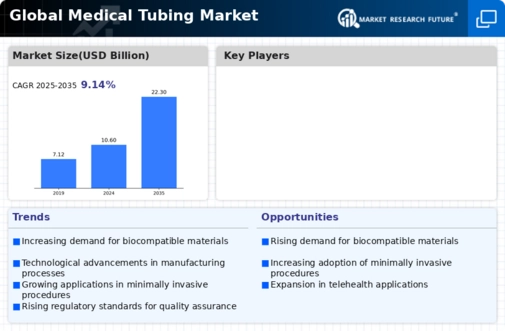Market Analysis
In-depth Analysis of Medical Tubing Market Industry Landscape
The medical tubing market is driven by a complex interplay of market dynamics that shape its growth and development. One of the primary dynamics is the increasing demand for advanced medical procedures. As medical technology evolves, there is a growing need for sophisticated tubing that can meet the specific requirements of new devices and treatments. This includes tubing used in minimally invasive surgeries, intravenous therapy, catheters, and diagnostic equipment. The rising prevalence of chronic diseases and the aging global population further fuel this demand, as these factors lead to an increased number of medical interventions.
Technological advancements are another critical dynamic influencing the market. Innovations in materials science have led to the development of high-performance tubing materials such as silicone, thermoplastic elastomers (TPE), and polyvinyl chloride (PVC). These materials offer superior characteristics like biocompatibility, flexibility, and chemical resistance, which are essential for medical applications. The continuous research and development efforts by companies to enhance the properties of these materials contribute significantly to the market's growth.
Regulatory factors also play a vital role in shaping the medical tubing market. The healthcare industry is heavily regulated to ensure patient safety and product efficacy. Compliance with stringent regulations and standards, such as those set by the FDA in the United States or the European Medicines Agency in the EU, is mandatory for market players. These regulations impact product development, manufacturing processes, and quality control measures. While compliance can be costly and time-consuming, it also ensures that only high-quality and safe products are available in the market, thereby boosting consumer confidence.
Economic factors, including healthcare expenditure, also significantly impact the medical tubing market. In regions with high healthcare spending, there is generally more investment in advanced medical infrastructure and technologies, leading to higher demand for medical tubing. Conversely, economic downturns can constrain healthcare budgets, potentially slowing market growth. Additionally, the increasing healthcare expenditure in emerging economies, driven by government initiatives and improving healthcare infrastructure, presents substantial growth opportunities for the market.
Market competition is a dynamic force that drives innovation and improvements in the medical tubing sector. The presence of numerous manufacturers and suppliers fosters a competitive environment where companies strive to differentiate their products and gain market share. This competition leads to continuous advancements in product quality, features, and cost-effectiveness, ultimately benefiting healthcare providers and patients. Companies invest in marketing and branding strategies to build strong reputations and increase their market visibility.
Patient safety and infection control are crucial dynamics in the medical tubing market. The need to prevent infections and ensure patient safety has led to the development of tubing with antimicrobial and anti-thrombogenic properties. These specialized coatings help reduce the risk of infections and blood clots, which are critical considerations in medical settings. The focus on improving patient outcomes drives the demand for such advanced tubing solutions.
The expansion of healthcare services in developing regions is another dynamic shaping the market. As countries invest in healthcare infrastructure to improve accessibility and quality of care, the demand for medical tubing rises. This is particularly evident in rapidly developing economies where there is a push to modernize healthcare facilities and provide better medical services. Companies that expand their operations into these regions can tap into new markets and drive growth.
Sustainability and environmental concerns are increasingly influencing the medical tubing market. There is a growing emphasis on developing eco-friendly products and sustainable manufacturing practices. Companies are exploring the use of recyclable materials and minimizing their environmental footprint. This focus on sustainability not only helps meet regulatory requirements but also appeals to environmentally conscious consumers and healthcare providers.



Leave a Comment